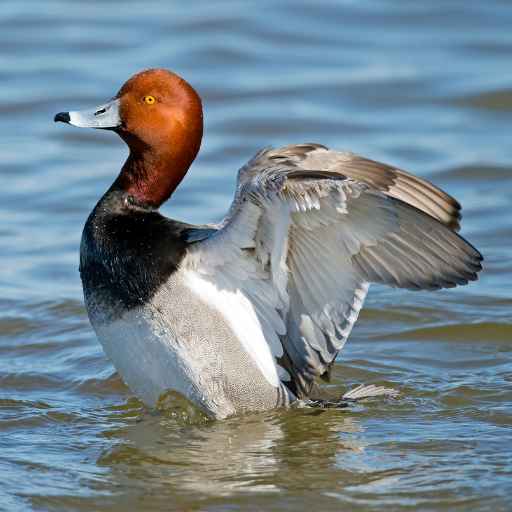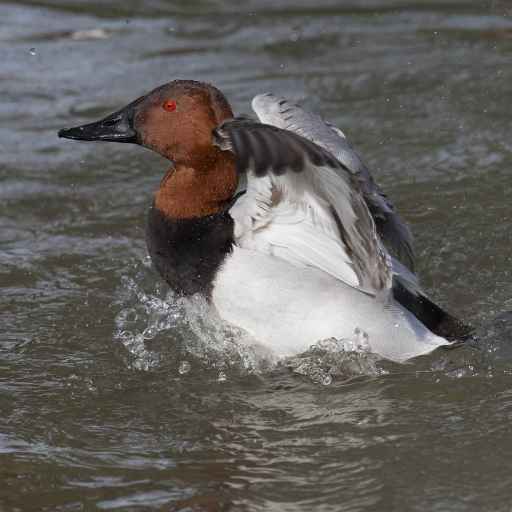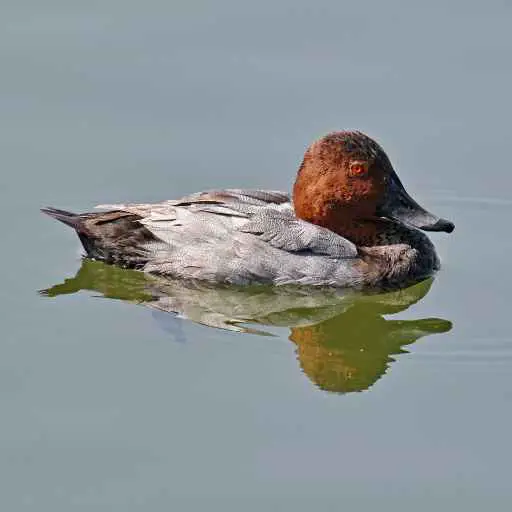If you’re a bird lover or enjoy duck-watching, then the four breeds of ducks featured in this article will charm your socks off! With their red heads and accompanying feathery coats, these ducks will capture your heart with their adorable physical features.
Read on to discover more about the captivating beauty of four species of ducks with red heads!
Redhead (Males)
Redhead

Beautiful & Majestic Redheads
- Redheads lay eggs in the nests of other birds, sometimes in the nests of other redheads.
- The redhead duck can be found in many habitats, including marshes, wetlands, lakes, ponds, and rivers.
- Male redhead ducks are known for their rounded red head and black breast.
The redhead (Aythya americana) is a duck native to North America. It is related to the scaup and the ring-necked duck. This beautiful bird is known for its distinctive red head, which makes it easily recognizable. Its has a gray body, lighter underbelly, and a white tail.
The male redhead is slightly larger than the female and has a more colorful appearance, with a brighter red head and a blue bill with black tip. Non-breeding males have a brown head.
Redheads are medium-sized diving ducks, meaning they feed by diving underwater using their webbed feet to reach for food at the bottom of the lake or river like other diving ducks.
Redheads feed on submerged aquatic plants, water lilies, invertebrates, and small fish. On dry ground, they are known to forage waste grains in agricultural fields.
Redheads winter along the Atlantic coast, Chesapeake Bay, South Carolina, the Great Lakes region, the Gulf Coast region, Laguna Madre in Texas and even further south to Mexico and Central America. They usually arrive at their wintering grounds in early November and leaving in late April.
Redheads breed in the late spring to early summer in the Great Plains, western Canada and Alaska. During this time, the male redhead establishes a territory and attracts a mate through elaborate courtship displays and calls.
During the breeding season, adult female redheads lay eggs in the nests of other ducks and birds such as those used by the American bittern. Some female redheads even lay eggs in female canvasback nests. The usual clutch size is 7 to 14 eggs.
Canvasback
Canvasback

Scarlet & Sprightly Canvasback
- The canvasback is a large duck with a long neck, sloping forehead, red eyes and chestnut head.
- The male canvasback is distinguished by its chestnut head and neck with a white back that gleams in the light.
- Canvasbacks feed on plants such as wild celery, pondweed and bulrushes, and small invertebrates like mollusks to supplement their diet.
Canvasbacks are large ducks with a length of around 20-24 inches and a wingspan of about 32-39 inches. They have a long, slender neck, a sloping forehead, red eyes, a chestnut-colored head, and a blue-gray back that contrasts the duck’s white underparts.
The male canvasback is particularly striking, with a chestnut head and neck and a white back that gleams in the light.
The canvasback is a dabbling duck, which means it feeds by dipping its head into the water to reach aquatic vegetation rather than diving for its food like some other species of ducks. It feeds primarily on plants and seeds, including wild celery, pondweed, and bulrushes. It supplements its diet by feeding on small invertebrates and mollusks.
Canvasbacks breed in the northern parts of North America, including Canada, Alaska, and the northern United States. They are migratory birds traveling to their wintering grounds in the southern United States, Mexico, and parts of Central and South America.
During their migration, they can be seen in large flocks along the coasts and on major rivers, providing a spectacular display for birdwatchers and naturalists.
The Canvasback duck is considered a species of Least Concern by the International Union for Conservation of Nature (IUCN). Although their populations have declined due to habitat loss, hunting, and other factors, they have been making a comeback in recent years due to conservation efforts and the protection of their breeding and wintering habitats by various organizations, including the U.S Fish and Wildlife Service.
Smew (Female)
Smew

Graceful & Aquatic Smew
- The smew is a compact duck with a round head.
- Adult females have glossy brown napes and reddish-brown heads, while adult males have black and white heads.
- Smews inhabit freshwater habitats such as freshwater lakes or rivers, feeding on fish and small aquatic invertebrates.
The smew (Mergellus albellus) is a charming duck species belonging to the Mergidae family. These ducks are widespread throughout the northern hemisphere and are easily recognizable due to their stunning black and white plumage.
The smew is a small duck, only measuring about 40 cm long and weighing an average of 500 g. It has a compact body and a rounded head, which gives it a charming look.
The female smew duck has a glossy brown nape and hindneck, a crisp white throat, and lower cheeks. Her upper parts, including her tail, are grey with less white patterning than the male. Her breast and flanks are mottled greys, becoming darker on her rear flanks.
The bill is black with serrated tips, and the legs are orange-yellow. Her eyes are brown with an amber iris and pale yellow ring, making her appearance dazzling. In flight, she displays elongated white patches on her primaries and a bright white underside.
The adult male smew is a medium-sized duck with a white face, neck, and underparts, contrasting with a dark grey mantle and upper parts. Its wings are black and white with two narrow black lines, and its rump, tail, and flanks are pale grey with white markings.
Smews are found in freshwater habitats, such as large lakes, marshes, and rivers, where they feed on fish, crustaceans, mollusks, aquatic insects and other small invertebrates.
Smews are migratory birds, and during the winter, they can be seen in southern regions where the water does not freeze.
Common Pochard
Common Pochard

Elegant & Plump Common Pochard
- The common pochard is a widespread medium-sized diving duck in many parts of Eurasia and Africa.
- This species feeds primarily on emergent vegetation, mollusks, and crustaceans which they search for underwater using agile swimming skills.
- Common pochards are vulnerable species that need conservation efforts due to habitat loss and degradation, causing population decline over time.
The common pochard (Aythya ferina) is a medium-sized diving duck native to Eurasia and parts of Africa. It has a body length of 17-20 inches and a wingspan of 28-32 inches.
The male common pochard has a blackish upper mantle, tail, rump, and breast, and a pale grey body with dark vermiculations. It has a rufous-chestnut head with a peaked crown and a concave profile. The bill is dark grey with a pale grey band and black nail, and the eyes are orange-red.
The female common pochard has grayish-brown overall with darker underparts and browner wings than the male. Her head is dull brown with narrow, pale gray eyestripes and a blackish bill.
The common pochard is an agile swimmer, able to dive and swim underwater in search of food. It feeds primarily on aquatic vegetation, mollusks, insect larvae and crustaceans.
During breeding, the birds form pairs and nest in shallow water or on the shore. The female lays up to 10 eggs in a nest made from plant material, which she incubates alone. In most cases, the male remains with the female to share chick-rearing duties.
The common pochard is a vulnerable species, and its population is declining due to habitat loss and degradation. Conservation efforts are needed to ensure the continued survival of this species.
Key Takeaways on Red-headed Duck
- There are four duck species with red heads — redheads, canvasbacks, smews and common pochards.
- These ducks are omnivores, primarily eating aquatic vegetation while supplementing their diets with small fish and invertebrates.
- Most of these ducks are migratory, leaving their breeding grounds for warmer climates in winter.


